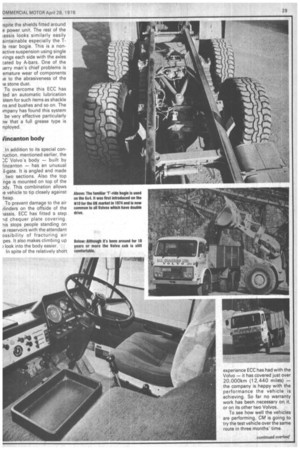Volvo's tipper in Wessex work -out
Page 29

Page 30

Page 31

If you've noticed an error in this article please click here to report it so we can fix it.
In operational trial by Stephen Gray
HE Volvo F86 can be found Milling many transport roles from maximum weight .unking down to refuse colIction. In all its guises, howver, it still uses the same asic 6.7-litre (409cuin) ower unit coupled to an ight-speed all-synchromesh earbox.
Although this small engine roduces enough power — 50kW (201 bhp) — to be used !gaily at 32 tons, it is much lore flexible when used in the iwer weight categories.
One of the better applications )1the F86 is, then, as a 6x4 pper running at 24 tons gross. de have already carried out a .111 road test on this model (CM, larch 25, 1977) but when ilsa Trucks told us of a special
bodied version which can tip extra close to heaps and is being used by English China Clay Quarries at Fronne Somerset we decided to carry out a purely operational trial of the vehicle to see how it performs in its working environment.
The ECC quarry at Frome manufactures asphalt as well as supplying quarry stone, so the vehicles in its 25 strong fleet have to be dual-purpose.
The majority of the work involves asphalt, so EEC needs insulated bodywork. However, for the odd occasions when ordinary stone is hauled the body must be strong enough to take the strain. For this reason steel interior flooring and sides are used with the outer clad in aluminium planking.
Super singles Unfortunately this makes the body rather heavy thus reducing payload capacity. However, ECC has won back some of the payload disadvantage by specifying super single tyres for the rear axles. This reduces unladen weight by 254kg {5cwt) — a saving which ECC estimates earns the company an extra £1,500 per annum. But there are other advantages with using super singles.
Despite costing no more than a pair of conventional tyres, a super single will, in ECC's experience, give over 48,000 miles before needing replacement. Unladen ride, too, is
vastly better than conventional twin _tyres as the super singles cushion road shocks to a great degree.
To see how the Volvo, one of three in a fleet made up mostly of AECs, performed on the hilly roads round the quarry we loaded it to near maximum weight and drove down the A359 from Frome to Yeovil. From there we picked up the A30 eventually turning off to Gillingham and so back to Frome via Mere. This proved to be 125 km (78 miles) and the Volvo, which was fitted with a flow meter to record consumption, returned 34.4 lit 100km (8.2mpg). ECC reckons to be getting over 28.2 lit/100km (10mpg) but this is running empty 40 per cent of the time.
The Volvo F86 cab probably needs no introduction. It has been around for over 10 years now and is, it must be admitted, showing it. Nevertheless, it is still comfortable — our test vehicle had the Bostrorn Viking driving seat — and quiet with carpeting over the engine hump.
The tipping controls are mounted in the centre of the dash at the lower edge although convenient enoul reach from the driving mean that the driver swivel back into position if looking out of the door d tipping.
Power steering
All driving controls are placed, with the gear I nicely close to hand by offside seat. The park t lever is mounted near it oi engine cover.
I found the Volvo nic drive with light but effe power-steering and gooc ward vision. In addition to mal service and secon braking, the Volvo is equi with an exhaust brake A have said before, this parti unit isn't very effective ar fact simply makes a noise out actually slowing the ye by any appreciable arric However, the service biwere excellent and showe signs of fade despite contin application on steep descer
Access to the power unit important point on any vet especially a tipper, and her Volvo scores with its quic cab.
Although it tilts to only the engine and its ancillarie: be reached without diffic !spite the shields fitted around e power unit. The rest of the iassis looks similarly easily aintainable especially the Tie rear bogie. This is a nonactive suspension using single lrings each side with the axles :ated by A-bars. One of the wry man's chief problems is emature wear of components ie to the abrasiveness of the le stone dust.
To overcome this ECC has ted an automatic lubrication stem for such items as shackle ns and bushes and so on. The impany has found this system be very effective particularly )w that a full grease type is nployed.
ilincanton body
In addition to its special conruction, mentioned earlier, the 2C Volvo's body — built by fincanton — has an unusual il-gate. It is angled and made two sections. Also the top nge is mounted on top of the xly. This combination allows ie vehicle to tip closely against heap.
To prevent damage to the air rlinders on the offside of the iassis, ECC has fitted a step id chequer plate covering. iis stops people standing on le reservoirs with the attendant ossibility of fracturing air pes. It also makes climbing up ) look into the body easier.
In spite of the relatively short experience ECC has had with the Volvo — it has covered just over 20,000km (12,440 miles) — the company is happy with the performance the vehicle is achieving. So far no warranty work has been necessary on it, or on its other two Volvos.
To see how well the vehicles are performing, CM is going to try the test vehicle over the same route in three months' time.




























































































































